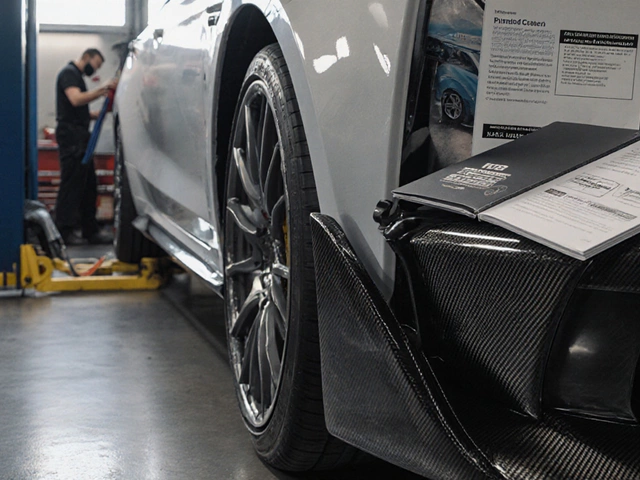So you want that aggressive look—new bumpers, side skirts, all the stuff guaranteed to make your car stand out. But you’re probably stuck on this question: will a body kit kill my warranty? A lot of folks hear 'any modification voids your warranty' and panic. Hold up. It’s not that simple.
Warranty rules aren’t cut and dried. Just because you slap on a new bumper doesn’t mean your whole warranty goes up in smoke. Car warranties don’t disappear because of a body kit alone. The real question is: did the mod cause the problem you’re trying to get fixed at the dealership?
Sometimes, dealerships try to dodge repairs, blaming the mod even when it’s not related. But there are laws, like the Magnuson-Moss Warranty Act in the U.S., that say manufacturers actually have to prove your body kit caused the damage. So unless your new side skirt somehow cracks the transmission (that would be a wild design flaw), the factory warranty stands for unrelated parts.
Quick tip: Always hang onto your receipts and take before/after photos. If a dealer tries to push blame on your kit, you’ll want proof showing it didn’t mess with what’s broken. And maybe check if your body kit installation was done right—shoddy jobs can actually create problems, which gets messy with warranty claims.
- How Warranties Really Work
- What Installing a Body Kit Does
- Dealership Tactics and Warranty Claims
- Tips to Keep Your Warranty Safe
How Warranties Really Work
Let’s get real about car warranties—you don’t lose your warranty just by adding a new part like a body kit. Most factory warranties only cover things that break due to a defect in the car, not from your personal mods. If you bolt on a new bumper, your warranty for unrelated stuff, like your air conditioning or engine, isn’t magically canceled out.
Here’s the deal: the manufacturer or dealership has to prove a direct link between your modification and the part that needs fixing. That’s part of U.S. law (yep, it’s actually called the Magnuson-Moss Warranty Act). So if your paint job starts to bubble after you install a side skirt, but the engine dies, the two aren’t connected. Warranty still stands for the engine.
If you’re outside the U.S., many car makers still work on the logic that only the part you replaced or affected might not be covered—not the whole car. Sometimes, only parts directly touched by your body kit are excluded if problems pop up. This means if something happens to your new spoiler and it was a dealer-installed option, you’re usually in the clear. But if it’s from a random shop and falls off, you might be paying out of pocket.
- Factory warranty covers defects in materials and workmanship from the manufacturer.
- Routine service (oil changes, tire rotations) is not covered by warranty.
- Stuff you add—like a body kit—only affects warranty claims linked directly to the new part or its installation.
If a shop claims you “voided” your warranty because of a body kit, ask them to show you where your kit caused the issue. That alone shuts down a lot of arguments.
What Installing a Body Kit Does
Putting on a body kit sounds pretty basic—swap out the bumper, tack on spoilers, maybe add flared side skirts. In reality, it’s a very hands-on job. Most body kit dealers sell kits made from polyurethane, fiberglass, or ABS plastic. Each type fits differently and needs its own set of skills and tools to install right.
For most cars, adding a body kit doesn’t touch how the engine, transmission, brakes, or electronics work. The kit is really just cosmetic—think of it like changing your haircut, not getting a new heart. But here’s where things get interesting: shady or careless installs can cause headaches. For example, cut too deep into the fender and you might expose metal to rust, or cover up factory sensors and suddenly parking assist won’t work the way it used to.
If you're curious about cost and install time, check this out:
| Body Kit Material | Avg. Install Time | Avg. Cost (USD) |
|---|---|---|
| Polyurethane | 6-12 hours | $700-$1500 (kit only) |
| Fiberglass | 8-16 hours | $500-$1200 (kit only) |
| ABS Plastic | 6-10 hours | $800-$1600 (kit only) |
The key thing is, if you stick to bolt-on kits made for your exact car model, you lower your chances of warranty drama. Universal kits, on the other hand, often need drilling, trimming, or even removing structural pieces. That’s asking for trouble both on the road and in the service bay.
Also, keep in mind that most car manufacturers won’t support repairs if damage is linked to how the kit was attached. If rattling panels or poor fitment lead to water leaks or rust, that’s probably on you, not the warranty. Always go for a pro install or follow the instructions to the letter. Your future self (and your wallet) will thank you.

Dealership Tactics and Warranty Claims
Dealerships don’t all act the same when they see modifications. Some ignore your body kit and fix stuff as usual. Others get defensive and say your warranty’s void, even when your new side skirts have nothing to do with your transmission or electrical problems. That’s when knowing how the system actually works pays off.
The key thing: body kit mods don’t automatically delete your warranty. Dealers or manufacturers have to actually prove your upgrade caused the damage. That’s straight from the Magnuson-Moss Warranty Act in the U.S., and most other countries have similar rules. So, if your alternator goes and you’ve just installed a new rear diffuser, the two issues usually aren’t connected and your coverage should stand.
But, some service departments will play games. Tactics you might see include:
- Refusing a repair upfront, just because there’s an obvious mod.
- Saying “all modifications void your warranty,” hoping you won’t push back.
- Claiming your modification ‘could’ have contributed to the failure, without showing actual evidence.
If this happens, don’t panic. You have options:
- Ask them to put the denial in writing and explain specifically why your claim is refused.
- Request documentation showing how your modification caused the problem.
- If you get stuck, reach out to the car manufacturer directly or try another dealership.
- Sometimes, talking to friends in the local car community will tip you off about which dealerships are mod-friendly.
One quick heads-up—if the body kit was installed badly and caused rust, electrical issues, or airbag sensor problems, dealerships might have a fair point. But if it’s just cosmetic or purely external, those scare tactics about “warranty gone for good” are usually all bark, no bite. Knowing your rights and calmly standing your ground brings way better results than backing down the first time they push back.
Tips to Keep Your Warranty Safe
Worried you might step on a warranty landmine with your new body kit? There are some pretty simple guardrails to follow that make life way easier. It’s all about knowing what’s in your control before you roll up to the dealership and risk a headache.
The big one: always choose quality parts and professional installation. A factory warranty can be picky, but it’s a lot harder for any service advisor to shoot down a claim when it’s clear the body kit isn’t installed with duct tape or screws that shouldn’t be there. Some shops even specialize in dealership-friendly work; don’t be afraid to ask!
Let’s look at some specific, battle-proven tips:
- Read your warranty fine print. There’s boring stuff in there, but it spells out exactly what counts as a problem. Scan for the section on modifications—it tells you what could really void coverage.
- Keep all receipts and installation docs. It’s basic, but it’s your backup plan in case something goes sideways. Dealers like paperwork; give them what they want.
- Document everything. Take clear before/after photos. Snap pics under good lighting so you have proof your kit isn’t causing issues.
- Choose shops that know factory specs. Installers who work with new cars every day know how to avoid tripping factory sensors, parking assist, and airbag wiring—stuff that dealerships really care about.
Service advisors love to act like all mods are trouble, but the law says otherwise. The U.S. Federal Trade Commission is actually on your side. Here’s what they have to say:
"If something goes wrong with your car and you take it in for warranty repairs, the dealer must show that the aftermarket or recycled part caused the need for repairs before denying warranty coverage." — Federal Trade Commission
If you’re in the U.S., that’s the Magnuson-Moss Warranty Act at work. It puts the pressure back on the dealer to actually prove your kit is the problem—not just guess or blame mods by default.
For a little more peace of mind, here’s what the numbers tell us about warranty denials and modifications:
| Type of Mod | Claims Denied (U.S., %) | Common Warranty Complaints |
|---|---|---|
| Body Kits | 7% | Sensor errors, paint match |
| Suspension | 19% | Ride quality, alignment |
| Aftermarket Wheels | 12% | TPMS issues, rubbing |
| Performance Chips | 33% | Engine, transmission |
As you can see, body kits actually have a lower rate of warranty denials compared to anything that messes with the engine or suspension. Just use basic common sense and keep those paper trails. That’s what keeps your coverage safe if you ever end up in a warranty debate.




